Abstract
Global warming weakened the summer monsoon and increased the evaporation, leading to more contribution of local evaporation moisture to the local precipitation for the monsoon areas. However, the descriptions of the contribution of the local moisture to the total precipitation and its characteristics have not been known very well. In this paper, taking the middle and lower Reaches of the Yangtze River (MLRYR) as a case and using the precipitation recycling process model, we analyzed the characteristics of the contribution of the local moisture to the total precipitation and the possible reasons. The results show that: the seasonal difference in precipitation recycling rates is obvious, the precipitation recycling rates in spring and summer are small (18.30% and 19.30%), the maximum in autumn is 30.50%, and the precipitation recycling rates in all seasons except summer show a significant upward trend (about 1.70%/10a). Additionally, the water vapor input into MLRYR from four boundaries significantly reduced except for the eastern boundary, and the water vapor contribution from the South and East borders is in summer, and the water vapor contribution from the North and West borders is in autumn, winter and spring. We suggest that the model of the precipitation recycling rate is important to evaluate the contribution of different water vapor sources, and help to further improve the ability of river water prediction in flood season.
1. Introduction
The middle and lower reaches of the Yangtze River (MLRYR) is one of the regions with frequent precipitation anomalies and frequent droughts and floods in China [1,2,3,4]. As well, the disasters caused by droughts and floods in this area are always heavy since it is also an area with a developed economy, science, and technology, especially for regions under multi-joint action of large-scale atmospheric circulation [5].
The water cycle is one of the important processes of material movement and energy exchange in the natural environment. The acceleration of the water cycle will directly affect the weather process in various places, and even determine its climatic characteristics, precipitation anomalies such as droughts and floods are directly related to the water cycle [6,7,8,9]. The source of water vapor in precipitation mainly contains two parts, one is the external water vapor brought by the wind field; the other part is derived from the local water vapor [10,11]. In addition to local evaporation and transpiration, local water vapor is partially transported from other parts of the region. This part of the water vapor transfer is converted into precipitation in the region and returned to the local area without leaving the area under study. The precipitation recycle ratio (PRR) is the proportion of local evaporation contribution to the total precipitation of a region. It can well characterize the contribution of local water vapor to local precipitation. Combined with evaporation and precipitation, it can also explain the dry and wet conditions of the area. For example, in humid areas with high atmospheric moisture content, if the water vapor entering the area is less than the amount of water leaving the area, and the precipitation recycle rate in the area is high, then although it is a wet area, its precipitation will tend to decrease.
Although there have been some studies on the water cycle processes on the global and continental scales, these studies have revealed the facts of water cycling in some areas, but little research has been done on the laws governing regional water vapor budgets, especially precipitation recycle rates. How to analyze or explain the precipitation recycle rate, explain the variation law of precipitation recycle rate, and find the factors affecting the change of precipitation recycle rate are still difficult in research. As global climate change and human activities have an increasing impact on the water cycle, the actual significance of precipitation recycle rates in different natural geographical regions, especially ecologically fragile zones, is more obvious, not only can simulate the main process of the water cycle in the region, but also regional water resources development and utilization services.
Since 1970, the research on precipitation recycle ratio (PRR) has developed rapidly, and there have been many ways to evaluate the rate of precipitation recycling, each with its own characteristics. Budyko proposed a simple model for the one-dimensional water cycle process [12,13]. Brubakerextended the Budyko model to two dimensions, considering the spatiality of the region, using this method for parts of North America, South America, Europe, and Africa for assessment and comparison of precipitation recycling rates [10]. Eltahir and Bras define the PRR as the ratio of recirculating precipitation to total precipitation and reconstruct an assessment model [14,15]. Van der Enthas further developed the evaporation recycle model and evaluated the impact of global terrestrial evaporation on precipitation [16].
At present, the existing related research in China is mainly divided into two categories from the evaluation model. The first one is based on the evaluation model established by Elthair and Bras [14]. Among them, Kang H W et al. target precipitation recycle in central and southern regions of China, and the rate was evaluated. 20% of the total precipitation in the upper reaches of the Yangtze River comes from the evaporation of water vapor in the central and southern parts of China, 40% of the total precipitation in the MLRYR comes from this area, and the PRR has obvious seasonal variation [17]. As well, there is a significant increase in the inter-decadal scale. Fu, X. et. al. in PRR Considering the amount of change of water vapor in the air with time, it can be applied to the calculation of PRR less than the inter-month time scale [18]. The other is based on the two-dimensional numerical model established by Brubaker (1993). Guo, Y.P. studied the water vapor cycle changes in the Qinghai-Tibet Plateau for nearly 40 years [19,20]. The precipitation process in the plateau region mainly relies on the bureau. The groundwater circulation, and in the context of global warming, the PRR in the eastern part of the Qinghai-Tibet Plateau has increased significantly, and it is most obvious in summer. Yao, J.Q. et.al quantitatively studied the characteristics of water vapor recycling in the Tianshan area, and the main water vapor in the Tianshan area [21]. The water vapor transport from the westerly belt accounts for 8% of the total precipitation, and the PRR gradually decreases with the increase in altitude.
This paper uses the climatological data of nearly 35 years to observe the temporal and spatial variation characteristics of water vapor recycle rate in the MLRYR and discuss the causes of the changes.
2. Data and Method
2.1. Data
The data selected in this paper is from the NCEP/NCAR reanalysis data, such as wind field, specific humidity, ground pressure, and other monthly data, NCEP latent heat flux, and temperature data processing, the horizontal resolution of the data is 2.5° × 2.5°, the selected year for the 1981–2015 total of 35 years of data, including wind field, specific humidity and other data including 1000 hpa to 300 hpa 8 layers of data.
The research area of this paper is the MLRYR, with 25° N–35° N and 110° E–122.5° E as the regional range.
2.2. Method
According to the definition proposed by Brude and Zangvil [20], precipitation in a study area can be divided into two parts depending on the source of water vapor:
The Pr is the part of the precipitation that contributes to the regional recycling, the water vapor comes from the study area, and the Pa contributes to the water vapor input from the outside world. Then, the PRR for a study area (x, y) at t time is defined as:
Similar to precipitation, evaporation in a study area can also be divided into two parts:
Wherein Er is the total evaporation of the study area through the evaporation of water vapor recycling to the local portion of Evapotranspiration, the Ea is the total evaporation through the vapor advection to other areas of that part of evaporation. Then, the evaporation cycle rate of a study area (x, y) at t time can be written as follows:
All computational models are based on the atmospheric water balance equation:
The Sa is the atmospheric water storage value, 𝜕 (Saμ)/𝜕x is due to the zonal ping flow caused by the atmospheric water storage value changes with the Latitude, 𝜕 (Sav)/𝜕y is due to the ping flow caused by the atmospheric water stored value with the change in longitude.
The results of the boundary layer experimental data show that, water vapor molecules from the surface evaporation, in the 15 min can be mixed to a height of 1 km, so it can be assumed that the atmosphere of water vapor is fully mixed, then Equation (5) The ratio of each item can be considered equal, that is [15,22]:
For an area, the vapor flux includes both input and output, and the atmospheric precipitation can be decomposed into two parts of income and expenditure:
If only the income situation is considered, then
Wherein r(t, x, y) is at (x, y) at the time of the water vapor recycling ratio, Sa-in-r is the (x, y) region of the Atmospheric Air column in the increase in water vapor from the local part, that is, local evaporation, Sa-in is (x, y) region of the atmosphere in the Air column increased water vapor volume, which consists of two parts, Part of the water vapor brought into the region by the advection, this part of the water vapor input is calculated using the “box” model, and the other part is the water vapor increase caused by local evaporation. This paper mainly uses two kinds of calculation schemes, one is to select the study area as a single lattice point (Equation (9)), and the other is to use the study area as a box to calculate, of course, the study area is at least 2 lattice points (Equation (10)).
In the equations, r(i, j, t) is PRR for the lattice point (i, j) at the time t; E(i, j, t) is the evaporation per unit area for the lattice point; S(i, j) for the area of the lattice point, Qin(i, j, t) for the water vapor input. Equation (10), r(t) is the study of the water vapor recycling ratio at t time; Qin-region is the study area water vapor input. Because the water vapor input and output of each layer are different, the water vapor input and output of each layer are calculated first, and then the water vapor input and output of the whole layer are calculated vertically.
3. Results
3.1. The Spatial-Temporal Distribution of PRR in the MLYR in China during the Last 35 Years
Figure 1A is the MLRYR 1981–2015 PRR distribution map, the MLRYR PRR is between 0–10%, from southeast to northwest north of the ladder shape, the highest value appears in northwestern Hubei province with 9.60%, the lowest value appears in the south of Jiangxi Province with 5.80%.
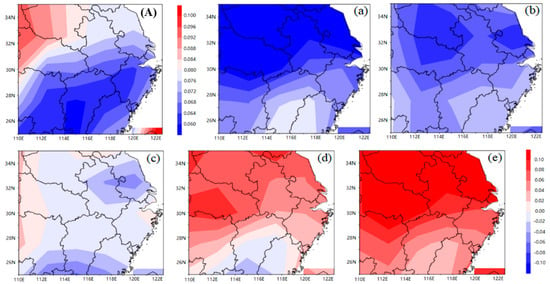
Figure 1.
(A) Distribution chart of 35 years climatic mean for PRR during 1981−2015 in the MLRYR, (a–e) are the differences of PRR between (a) 1981–1995, (b) 1986–2000, (c) 1991−2005, (d) 1996–2010, (e) 2001–2015 and (A) 1981–2015. (a–e) is a slide average of the PRR in the MLRYR, as can be seen from (a,b), the PRR is significantly less than the average, and the degree of the water vapor is gradually increasing from south to north; from (c,d), the PRR is significantly higher than the average, and the degree of increase from south to north gradually increases. It is obvious from Figure 1 that the PRR in the MLRYR has increased markedly in the last 35 years, and the fastest increase is in the northern MLRYR region.
3.2. The Annual, Inter-Annual and Inter-Decadal Changes in PRR over MLRYR
The study area is selected as the whole of the MLRYR, then the annual average PRR in the region is changed in the last 35 years (Figure 2), the minimum is 20.00% (1994) and the maximum value is 27.50% (2011) by using Equation (10). In the past 35 years, the trend has been increasing gradually, trend value is 1.30%/10a, and pass the 95% significance test. According to the principle of drought and waterlogging index and spatial distribution consistency, the year of flood in the Yangtze River basin was 1998 and 1983, which corresponded to the minimum PRR, this can be understood as the significant increase in the amount of external water vapor compared to previous years.
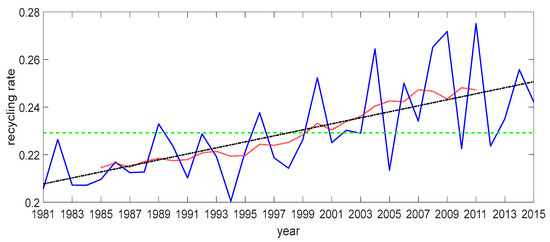
Figure 2.
Annual average of precipitation recycling ratio in the middle and lower reaches of Yangtze River during 1981–2015 (Blue polyline). The green dotted line is the multi-year mean value, the black dotted line is the linear trend, and the red discount is the 9-year sliding mean value.
The monthly distribution of PRR in the MLRYR is shown in Figure 3 that which has a significant monthly change, of which the PRR in January–May is basically the same, floating at 25.00%, and the lowest value appearing in June is 19.29%. Since June it began to rise rapidly and reached the highest value of 43.04% in September. The PRR decreased rapidly from September to October and then reduced slowly for November to December.
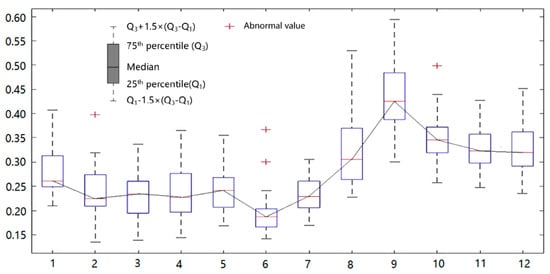
Figure 3.
Monthly precipitation recycling ratio in the middle and lower Yangtze River region (1981–2015).
The PRR in the MLRYR has obvious inter-annual variation, so we can guess that the PRR in the MLRYR should also have obvious seasonal characteristics.
In the MLRYR, the PRR during the last 35 years is obviously different among the four seasons (Figure 4). The PRR in spring is 18.30% and shows an upward trend with a rate of 1.70% per decade, which passes the 95% significance test. Although the precipitation recycling rate in the summer from 1981 to 2015 showed a slight downward trend (−0.043%/10a), it did not pass the 95% significance test, and the summer PRR was relatively small (19.30%). The precipitation recycling rate in autumn is 30.50%, and it is increasing with a trend coefficient of 1.70% per decade, which passes the 95% significance test. The winter precipitation recycling rate is second only to autumn (23.60%). The winter PRR in 1981–2015 showed a significant upward trend (passing the 95% significance test) with a trend coefficient of 1.80% per decade.
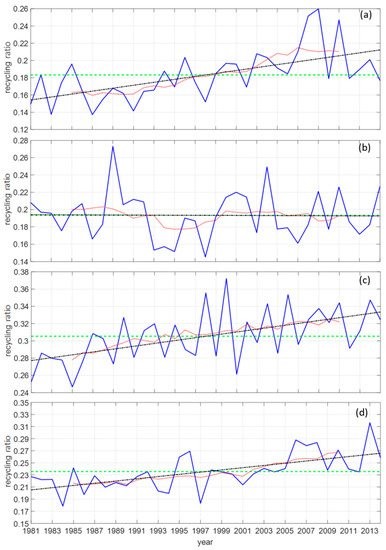
Figure 4.
Interannual variability of precipitation recycling ratio in the middle and lower reaches of Yangtze River (a) spring (b) Summer (c) Fall (d) Winter (Blue polyline). The green dotted line is the multi-year mean value, the black dotted line is the linear trend, and the red discount is the 9-year sliding mean value.
3.3. Possible Reasons behind the Characteristics of PRR over MLRYR
In the MLRYR, there is an obvious seasonal variation of the water vapor recycling ratio (Figure 4), and we know that the MLRYR is the monsoon region, the ocean brings abundant water vapor, which constitutes the water vapor source, so we’re entering the water vapor in the MLRYR from four borders to explore how they change over the year. From Figure 5, the south and west boundaries are dominated by water vapor input. Specifically, the water vapor input at the northern boundary is the smallest in summer (almost zero in July and August), while the water vapor input at the southern boundary is relatively large in spring and summer. The water vapor input at the western boundary is the smallest, and the water vapor input at the eastern boundary is only large in late summer and early autumn, other times have basically no input.
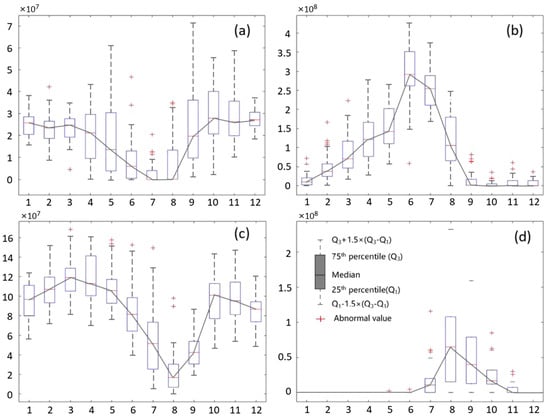
Figure 5.
Total monthly water vapor input from each boundary year in the middle and lower reaches of Yangtze River (1981–2015) (a) north boundary (b) south boundary (c) west boundary (d) east boundary.
The water vapor recycling ratio is increasing every year, which represents the region’s moisture circulation, the proportion of water vapor from the local area is increasing, and the moisture circulation is more dependent on local vapor. Two factors affecting the precipitation recycling ratio, one is the total water vapor input in the region, and one is the evaporation of the area. Figure 6a shows the average annual total water vapor input for the MLRYR from 1981–2015. On average, the annual average water vapor input is 1.7 × 108 kg · s−1, and its interannual changes are obvious. The annual average water vapor input is decreasing, with a trend coefficient of −8.02 × 105 kg · s−1 · a−1, and it passes the 95% significance test. In the year when the maximum moisture input was present, the water vapor recycling ratio of the year was mostly minimal.
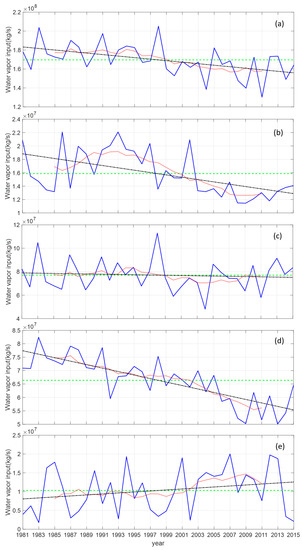
Figure 6.
Total annual water vapor translated to the middle and lower reaches of the Yangtze River during 1981–2015 for the total area (a), northern boundary (b), southern boundary (c), western boundary (d) and eastern boundary (e). (Units: kg·s−1) (Blue polyline). The green dotted line is the multi-year mean value, the black dotted line is the linear trend, and the red discount is the 9-year sliding mean value.
The total amount of water vapor input into the MLRYR is the sum of the water vapor input through its four boundaries. But which is the dominant area of water vapor input in the MLRYR? The annual total water vapor input into the MLRYR during 1981–2015 is shown in Figure 6a, which is 1.70 × 108 kg · s−1. Wherein, the water vapor input through the northern boundary is 1.59 × 107 kg · s−1, which shows a downward trend with the value of −1.75 × 105 kg · s−1 · a−1, passing the 95% significance test (Figure 6b); the water vapor input through the southern boundary was the largest (7.7 × 107 kg · s−1), and it shows a slight downward trend (−1.11 × 105 kg · s−1 · a−1) from 1981 to 2015, not passing the 95% significance test (Figure 6c); the water vapor input through the western boundary is 6.64 × 107 kg · s−1, showing a downward trend with a trend coefficient of −6.49 × 105 kg · s−1 · a−1, which passes the 95% significance test (Figure 6d); the water vapor input through the eastern boundary is the smallest (1.03 × 107 kg · s−1), and it shows a significant upward trend from 1981 to 2015 (passing the 95% significance test) with a trend coefficient of 1.32 × 105 kg · s−1 · a−1 (Figure 6e). In terms of magnitude, the south and west borders dominate, especially the southern boundary, which is about 7 times the eastern boundary with the least amount of water vapor input. The higher water vapor input in the south boundary occurred in summer, indicating that the water vapor sources in the MLRYR are mainly water vapor from the south, in which the southwest monsoon and the South China Sea monsoon from the Bay of Bengal, bring abundant water vapor.
4. Conclusions and Discussion
The MLRYR are in China’s humid and semi-humid regions, which are typical large river basins. There are many parks, forests, and wetlands, storing considerable water vapor and energy. With climate warming, the temperature in the MLRYR is also increasing [23,24,25]. These stored water resources will release a large amount of latent heat, which will affect the regional atmosphere circulation, and hydrological cycle, especially the PRR, and even will feedback on the climate of eastern China. Wherein, PRR is the key factor to judge the contribution of water resources to the local precipitation.
In this paper, we calculated PRR for MLRYR using the precipitation recycle ratio model, analyzed the characteristics of the contribution of the local moisture to the total precipitation of this area, and revealed the possible reasons. We found that the distribution of PRR shows an increasing trend, especially in the north of MLRYR (Figure 1). The PRR in different seasons is obviously diverse, for the PRR in spring and summer are small with 18.30% and 19.30% respectively, but it is the maximum in autumn with 30.50%, which is similar to the results by Fu Xiang who also used the above-mentioned recycling model to find that the PRR in MLRYR during the summer rainstorm period was about 30.00% [18]. Furthermore, the PRR in all seasons except summer shows a significant upward trend (about 1.70%/10a). This change is closely related to the significant reduction of water vapor input in the MLRYR. In addition, the average annual recycling rate of precipitation in the MLRYR calculated in this study is about 23.00%, which is inconsistent with the results by Kang Hongwen who found that the average annual PRR in the MLRYR is about 40.00% [17]. (The main reason for the difference may be the derivers’ recycling models they used). We suggest that the selection of the evaluation model of the PRR is important to evaluate the contribution of different water vapor sources, and help to further improve the ability of river water prediction in flood season [26,27] and assessment of regional drying and wetting trend and vegetation growth trend [28,29,30], which is worth of further researching systematically.
Author Contributions
Conceptualization, Y.-P.W., G.-L.F. and G.-Q.S.; methodology, Y.-P.W.; software, Z.-P.Z.; validation, X.-Y.W., M.L. and B.-C.H.; formal analysis, Z.-P.Z. and M.L.; investigation, X.-Y.W.; resources, G.-L.F.; data curation, Z.-P.Z.; writing—original draft preparation, Z.-P.Z. and X.-Y.W.; writing—review and editing, B.-C.H.; supervision G.-L.F.; visualization, Y.-P.W., G.-L.F.; project administration, G.-Q.S.; funding acquisition, Y.-P.W., G.-L.F. and G.-Q.S. All authors have read and agreed to the published version of the manuscript.
Funding
The project is funded by the National Natural Science Foundation of China (grant nos. 41875097, 42275029, 42130610, 42275034 and 41875096), National Key Research and Development Program of China (grant no. 2017YFC1502303, 2018YFE0109600), Southern Marine Science and Engineering Guangdong Laboratory, Zhuhai, China. Selective Support for Scientific and Technological Activities of Overseas Scholars of Shanxi province, and Outstanding Young Talents Support Plan of Shanxi province.
Institutional Review Board Statement
Not applicable.
Informed Consent Statement
Not applicable.
Data Availability Statement
The data selected in this paper is from the NCEP/NCAR reanalysis data: https://psl.noaa.gov/data/gridded/data.ncep.reanalysis.html, accessed on 10 November 2022.
Conflicts of Interest
The authors declare no conflict of interest.
References
- Ding, Y.; Wang, Z.; Sun, Y. Inter-decadal variation of the summer precipitation in East China and its association with decreasing Asian summer monsoon. Part I: Observed evidence. Int. J. Climatol. 2008, 28, 1139–1161. [Google Scholar] [CrossRef]
- Guo, W.K.; Wang, X.Y.; Gao, W.Z.; Yong, J.H.; Bao, X.Y.; Wu, Y.P.; Feng, G.L.; Dong, W.J. The Physical Mechanisms Behind the Change in the Precipitation Recycling Rate in the Mid- and Lower Reaches of the Yangtze River. Front. Phys. 2021, 688801. [Google Scholar] [CrossRef]
- Zhai, P.; Zhang, X.; Wan, H.; Pan, X. Trends in Total Precipitation and Frequency of Daily Precipitation Extremes over China. J. Clim. 2005, 18, 1096–1108. [Google Scholar] [CrossRef]
- Zou, M.; Qiao, S.; Feng, T.; Wu, Y.; Feng, G.-L. The Interdecadal Change in Anomalous Summertime Water Vapor Transport Modes over the Tropical Indian Ocean-Western Pacific in the mid-1980s. Int. J. Climatol. 2018, 38, 2672–2685. [Google Scholar] [CrossRef]
- Wu, Y.-P.; Shan, Y.-P.; Feng, G. Characterizations of Water Vapor Flux and Precipitation over Arid Region under Climate Change. Mater. Sci. Eng. 2014, 440, 1028–1031. [Google Scholar] [CrossRef]
- Jackson, R.B.; Carpenter, S.R.; Dahm, C.N.; Mcknight, D.M.; Naiman, R.J.; Postel, S.L.; Running, S.W. Water in a Changing World. Ecol. Appl. 2001, 11, 1027–1045. [Google Scholar] [CrossRef]
- Rios-Entenza, A.; Soares, P.M.M.; Trigo, R.M.; Cardoso, R.M.; Miguez-Macho, G. Moisture recycling in the Iberian Peninsula from a regional climate simulation: Spatiotemporal analysis and impact on the precipitation regime. J. Geophys. Res. Atmos. 2014, 119, 5895–5912. [Google Scholar] [CrossRef]
- Hua, L.; Zhong, L.; Ke, Z. Characteristics of the precipitation recycling ratio and its relationship with regional precipitation in China. Theor. Appl. Climatol. 2017, 127, 513–531. [Google Scholar] [CrossRef]
- Zhang, W.; Zhou, T.; Zhang, L.; Zou, L. Future Intensification of the Water Cycle with an Enhanced Annual Cycle Over Global Land Monsoon Regions. J. Clim. 2019, 32, 5437–5452. [Google Scholar] [CrossRef]
- Brubaker, K.L.; Entekhabi, D.; Eagleson, P.S. Estimation of contin- ental precipitation recycling. J. Clim. 1993, 6, 1077–1089. [Google Scholar] [CrossRef]
- Dominguez, F.; Kumar, P.; Liang, X.Z.; Ting, M. Impact of atmospheric moisture storage on precipitation recycling. J. Clim. 2006, 19, 1513–1530. [Google Scholar] [CrossRef]
- Budyko, M.I.; Drozdov, O.A. Zakonomernosti vlagooborota vatmosfere. Regul(Regularities of the hydrologic cycle in the atmosphere). Izv. Akad. Nauk SSSR Ser. Geogr. 1953, 4, 5–14. [Google Scholar]
- Budyko, M.I. Climate and Life; Academic Press: New York, NY, USA, 1974. [Google Scholar]
- Eltahir, E.A.B.; Bras, L.B. Precipitation recycling in the Amazon Basin. Q. J. R. Meteorol. Soc. 1994, 120, 861–880. [Google Scholar] [CrossRef]
- Eltahir, E.A.B.; Bras, L.B. Precipitation recycling. Rev. Geophys. 1996, 34, 367–378. [Google Scholar] [CrossRef]
- Van der Ent, R.J.; Savenije, H.H.; Schaefli, B.; Steele-Dunne, S.C. Origin and fate of atmospheric moisture over continents. Water Resour. Res. 2010, 46. [Google Scholar] [CrossRef]
- Kang, H.W.; Gu, X.Q.; Zhu, C.W. Evaluation of Precipitation Recycling Rates in Central and Southern China. J. Atmos. Sci. 2004, 28, 892–900. (In Chinese) [Google Scholar]
- Fu, X.; Xu, X.D.; Kang, H.W. Research on Precipitation Recycling during Meiyu Season over Middle-Lower Reaches of Changjiang River in 1998. Meteorol. Sci. Technol. 2006, 34, 394–399. (In Chinese) [Google Scholar]
- Guo, Y.; Wang, C. Trends in precipitation recycling over the Qinghai-Xizang Plateau in last decades. J. Hydrol. 2014, 517, 826–835. [Google Scholar] [CrossRef]
- Wu, Y.-p.; Shen, Y.-p.; Li, B.L. Possible Physical Mechanism of Water Vapor Transport over Tarim River Basin. Ecol. Complex. 2012, 9, 63–70. [Google Scholar] [CrossRef]
- Yao, J.Q.; Yang, Q.; Wu, L.K.; Xu, X.B. Quantitative Research on Water Vapor Recycling in Tianshan Area. Dessert Oasis Meteorol. 2016, 10, 37–43. (In Chinese) [Google Scholar]
- Burde, G.I.; Zangvil, A. The estimation of regional precipitation recycling. Part I: Review of recycling models. J. Clim. 2001, 14, 2497–2508. [Google Scholar] [CrossRef]
- Xian, S.; Zhenshan, L.; Xiaoxia, C.; Chuangye, J. Regional features of the temperature trend in China based on Empirical Mode Decomposition. J. Geogr. Sci. 2008, 18, 166–176. [Google Scholar]
- Zhao, J.; Zhang, H.; Zuo, J.; Yang, L.; Yang, J.; Xiong, K.; Feng, G.; Wenjie, D. Oceanic drivers and empirical prediction of late summer precipitation variability over Northeast China. Clim. Dyn. 2021, 58, 861–878. [Google Scholar] [CrossRef]
- Zhao, J.; Yang, L.; Feng, G. The Circulation System Configuration Characteristics of Four precipitation Patterns in Summer over the East China monsoon region. Theor. Appl. Climatol. 2018, 131, 1211–1219. [Google Scholar] [CrossRef]
- Guo-Lin, F.; Yang, J.; Zhi, R.; Zhao, J.-H.; Gong, Z.-Q.; Zheng, Z.-H.; Xiong, K.-G.; Qiao, S.-B.; Yan, Z.; Wu, Y.-P.; et al. Improved prediction model for flood-season precipitation based on a nonlinear dynamics-statistic combined method. Chaos Solitons Fractals 2020, 140, 110160. [Google Scholar]
- Wu, Y.-P.; Feng, G.-L. A new algorithm for seasonal precipitation forecast based on global atmospheric hydrological water budget. Appl. Math. Comput. 2015, 268, 478–488. [Google Scholar] [CrossRef]
- Xue, Q.; Sun, G.-Q.; Liu, C.; Guo, Z.-G.; Jin, Z.; Wu, Y.-P.; Feng, G.-L. Spatiotemporal dynamics of a vegetation model with nonlocal delay in semi-arid environment. Nonlinear Dyn. 2020, 99, 3407–3420. [Google Scholar] [CrossRef]
- Sun, G.-Q.; Wang, C.-H.; Li, L.; Wu, Y.-P.; Jin, Z. Effects of feedback regulation on vegetation patterns in semi-arid environment. Appl. Math. Model. 2018, 61, 200–215. [Google Scholar] [CrossRef]
- Wu, Y.-P.; Feng, G.L.; Li, B.L. Interactions of Multiple Atmospheric Circulation Drive the Drought in Tarim River Basin. Sci. Rep. 2016, 6, 26470. [Google Scholar] [CrossRef]
Publisher’s Note: MDPI stays neutral with regard to jurisdictional claims in published maps and institutional affiliations. |
© 2022 by the authors. Licensee MDPI, Basel, Switzerland. This article is an open access article distributed under the terms and conditions of the Creative Commons Attribution (CC BY) license (https://creativecommons.org/licenses/by/4.0/).